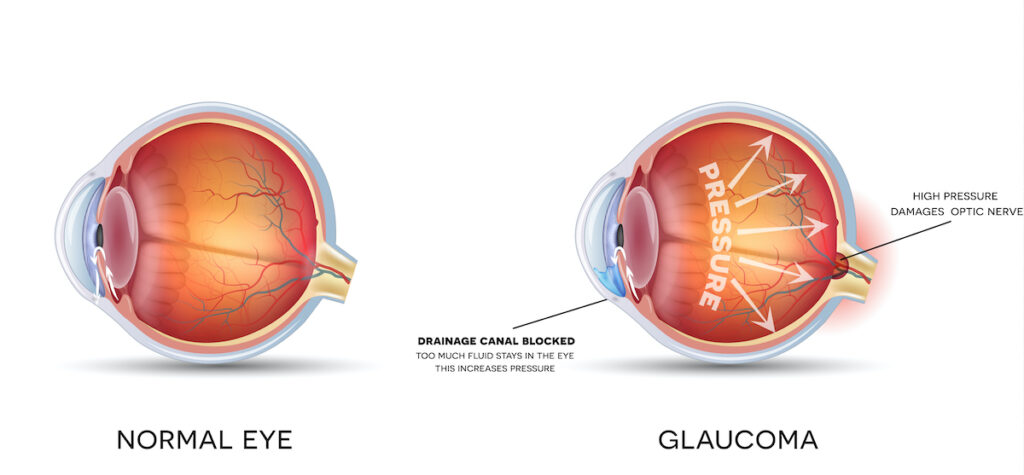Glaucoma
What is Glaucoma?
Glaucoma is an eye disease that damages your optic nerve, which sends light signals from your retina to your brain. Your brain then interprets those signals and forms the images you see.
Without your optic nerve, there is no way for visual information to reach your brain, and you can’t see. Glaucoma occurs when fluid builds up in your eye. Excess fluid increases your eye pressure, called intraocular pressure or IOP, which can damage your optic nerve.
Optic nerve damage and the vision loss it causes are permanent. The only way to prevent this is to catch and treat glaucoma early.

What are the Types of Glaucoma?
There are two primary types of glaucoma. Most glaucoma patients have primary open-angle glaucoma or POAG, which is painless and develops slowly.
The other type of glaucoma is angle-closure glaucoma. It is sometimes also called closed-angle glaucoma or narrow-angle glaucoma.
If you have angle-closure glaucoma, your iris blocks your eye’s drainage angle. This block causes your eye pressure to rise quickly and is extremely dangerous. If you don’t receive immediate medical attention, you may lose your eyesight.
What are the Symptoms of Glaucoma?
Glaucoma symptoms vary depending on the type you have. Open-angle glaucoma does not present symptoms at first. As it gets worse, you may notice blind spots in your periphery and tunnel vision.
If you have angle-closure glaucoma, you likely won’t notice symptoms until you have an acute attack.
The symptoms of an acute angle-closure glaucoma attack include:
- Blurry vision
- Severe eye pain
- Eye redness
- Headache
- Nausea or vomiting
- Rings or halos around lights
If you suddenly experience these symptoms, seek immediate medical attention.

How is Glaucoma Diagnosed?
Since POAG doesn’t have symptoms, it’s essential to see your ophthalmologist regularly. They can detect glaucoma during a routine eye exam.
During an eye exam, they check your IOP and examine your drainage angle. The test used to check your IOP is tonometry.
Usually, your eye doctor will hit your eye with a puff of air and then measure the resistance to that air. They need to dilate your pupils to check your drainage angle and optic nerve.
To do this, they give you eye drops that widen your pupils. Then they can look at all the components inside your eye to ensure health.
How Do You Treat Glaucoma?
Glaucoma treatments depend on the type of glaucoma you have and how advanced it is. If your eye doctor diagnosed your glaucoma early, you should be able to slow its progression.
More advanced glaucoma may need ongoing preventive care. Treatment is often a combination of medication and a medical procedure. All glaucoma treatments aim to reduce IOP to protect your optic nerve.
Medication
Glaucoma medication can be oral or come in the form of eye drops. Both are effective at reducing IOP.
The pills or drops lower IOP by reducing the amount of fluid in your eyes. Usually, they accomplish this by limiting the amount of eye fluid that your body makes.
Minimally invasive glaucoma surgery
Minimally invasive glaucoma surgery or MIGS is a collection of low-risk glaucoma surgeries. These procedures lower eye pressure and do not require excessive post-op care. There are two types of MIGS, I-STENT and Yag Peripheral Iridotomy or YAG PI.
I-STENT helps restore your eye’s natural fluid drain to lower IOP. It places a small implant in your eye that creates a new drainage pathway. I-STENT is an outpatient procedure performed under local anesthesia.
YAG PI treats acute angle-closure glaucoma. It is a painless laser procedure where your eye doctor makes a small opening in your iris. This opening allows the fluid to drain.
Do you need your eyes checked for glaucoma? Schedule an appointment at Cobb Eye Center in Dallas, GA, to ensure your eyes are safe!

